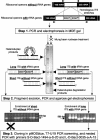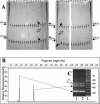Nature of polymorphisms in 16S-23S rRNA gene intergenic transcribed spacer fingerprinting of Bacillus and related genera
- PMID: 12957895
- PMCID: PMC194986
- DOI: 10.1128/AEM.69.9.5128-5137.2003
Nature of polymorphisms in 16S-23S rRNA gene intergenic transcribed spacer fingerprinting of Bacillus and related genera
Abstract
The intergenic transcribed spacers (ITS) between the 16S and 23S rRNA genetic loci are frequently used in PCR fingerprinting to discriminate bacterial strains at the species and intraspecies levels. We investigated the molecular nature of polymorphisms in ITS-PCR fingerprinting of low-G+C-content spore-forming bacteria belonging to the genera Bacillus, Brevibacillus, Geobacillus, and Paenibacillus: We found that besides the polymorphisms in the homoduplex fragments amplified by PCR, heteroduplex products formed during PCR between amplicons from different ribosomal operons, with or without tRNA genes in the ITS, contribute to the interstrain variability in ITS-PCR fingerprinting patterns obtained in polyacrylamide-based gel matrices. The heteroduplex nature of the discriminating bands was demonstrated by fragment separation in denaturing polyacrylamide gels, by capillary electrophoresis, and by cloning, sequencing, and recombination of purified short and tRNA gene-containing long ITS. We also found that heteroduplex product formation is enhanced by increasing the number of PCR cycles. Homoduplex-heteroduplex polymorphisms (HHP) in a conserved region, such as the 16S and 23S rRNA gene ITS, allowed discrimination of closely related strains and species undistinguishable by other methods, indicating that ITS-HHP analysis is an easy and reproducible additional tool for strain typing.
Figures






Similar articles
-
Homoduplex and heteroduplex polymorphisms of the amplified ribosomal 16S-23S internal transcribed spacers describe genetic relationships in the "Bacillus cereus group".Appl Environ Microbiol. 2000 Dec;66(12):5460-8. doi: 10.1128/AEM.66.12.5460-5468.2000. Appl Environ Microbiol. 2000. PMID: 11097928 Free PMC article.
-
Heteroduplex structures in 16S-23S rRNA intergenic transcribed spacer PCR products reveal ribosomal interoperonic polymorphisms within single Frankia strains.J Appl Microbiol. 2007 Oct;103(4):1031-40. doi: 10.1111/j.1365-2672.2007.03329.x. J Appl Microbiol. 2007. PMID: 17897207
-
16S-23S rRNA internal transcribed spacers as molecular markers for the species of the 16S rRNA group I of the genus Bacillus.FEMS Microbiol Lett. 1998 Jun 15;163(2):229-36. doi: 10.1111/j.1574-6968.1998.tb13050.x. FEMS Microbiol Lett. 1998. PMID: 9673027
-
PCR-based method for targeting 16S-23S rRNA intergenic spacer regions among Vibrio species.BMC Microbiol. 2010 Mar 23;10:90. doi: 10.1186/1471-2180-10-90. BMC Microbiol. 2010. PMID: 20331883 Free PMC article.
-
Reprint of New opportunities for improved ribotyping of C. difficile clinical isolates by exploring their genomes.J Microbiol Methods. 2013 Dec;95(3):425-40. doi: 10.1016/j.mimet.2013.09.009. Epub 2013 Sep 16. J Microbiol Methods. 2013. PMID: 24050948 Review.
Cited by
-
DNA polymorphisms and biocontrol of Bacillus antagonistic to citrus bacterial canker with indication of the interference of phyllosphere biofilms.PLoS One. 2012;7(7):e42124. doi: 10.1371/journal.pone.0042124. Epub 2012 Jul 27. PLoS One. 2012. PMID: 22848728 Free PMC article.
-
Comparison of different primer sets for use in automated ribosomal intergenic spacer analysis of complex bacterial communities.Appl Environ Microbiol. 2004 Oct;70(10):6147-56. doi: 10.1128/AEM.70.10.6147-6156.2004. Appl Environ Microbiol. 2004. PMID: 15466561 Free PMC article.
-
The use of loop-mediated isothermal DNA amplification for the detection and identification of the anthrax pathogen.Mol Gen Microbiol Virol. 2017;32(2):100-108. doi: 10.3103/S0891416817020094. Epub 2017 Sep 20. Mol Gen Microbiol Virol. 2017. PMID: 32214650 Free PMC article.
-
Diversity of Bacillus anthracis strains in Georgia and of vaccine strains from the former Soviet Union.Appl Environ Microbiol. 2006 Aug;72(8):5631-6. doi: 10.1128/AEM.00440-06. Appl Environ Microbiol. 2006. PMID: 16885320 Free PMC article.
-
Genotyping and toxigenic potential of Bacillus subtilis and Bacillus pumilus strains occurring in industrial and artisanal cured sausages.Appl Environ Microbiol. 2004 Sep;70(9):5168-76. doi: 10.1128/AEM.70.9.5168-5176.2004. Appl Environ Microbiol. 2004. PMID: 15345396 Free PMC article.
References
-
- Ash, C., J. A. E. Farrow, S. Wallbanks, and M. D. Collins. 1991. Phylogenetic heterogeneity of the genus Bacillus revealed by comparative analysis of small-subunit-ribosomal RNA sequences. Lett. Appl. Microbiol. 13:202-206.
-
- Ausubel, F. M., R. Brent, R. E. Kingston, D. D. Moore, J. G. Seidman, J. A. Smith, and K. Struhl. 1994. Current protocols in molecular biology. John Wiley and Sons, Inc., New York, N.Y.
-
- Bassam, B. J., G. Caetano-Anolles, and P. M. Gresshoff. 1991. Fast and sensitive silver staining of DNA in polyacrylamide gels. Anal. Biochem. 80:81-84. - PubMed
-
- Borin, S., D. Daffonchio, and C. Sorlini. 1997. Single strand conformation polymorphism analysis of PCR-tDNA fingerprinting to address the identification of Bacillus species. FEMS Microbiol. Lett. 157:87-93. - PubMed
Publication types
MeSH terms
Substances
LinkOut - more resources
Full Text Sources
Other Literature Sources
Molecular Biology Databases

